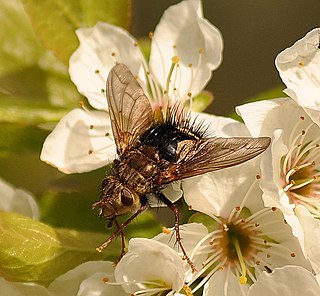 W
WArchytas apicifer is a medium to large sized Nearctic tachinid fly. The species name was authored by the German entomologist Johann Friedrich Jaennicke (1867) and presumably named after the Greek classical philosopher and mathematician Archytas. The larvae are parasites of several caterpillar species.
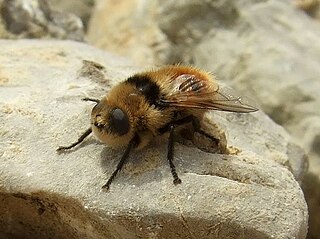 W
WBotflies, also known as warble flies, heel flies, and gadflies, are a family of flies technically known as the Oestridae. Their larvae are internal parasites of mammals, some species growing in the host's flesh and others within the gut. Dermatobia hominis is the only species of botfly known to parasitize humans routinely, though other species of flies cause myiasis in humans.
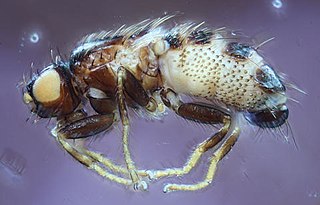 W
WCarnus hemapterus is a Dipteran insect, a small-bodied and partly black-coloured carnid fly. In their adult stage of life, they are blood-sucking ectoparasites of nestling birds. Within the genus Carnus, this is the only species widespread across Europe and the cold and temperate regions of Asia and North America. Female body length is about 1.5 mm, males are smaller. It typically occurs in the nests of medium- to large-bodied birds, provided that the nest is not on the ground. It is particularly common on the chicks of owls, falcons, rollers, bee-eaters and starlings. Females give birth to larvae that live within the nest and feed on organic debris and the pupae also overwinter there. The emergence of imagines is synchronized to the hatch of host nestlings in the subsequent year. They prefer larger chicks within the nest. Adult flies have a winged and an unwinged variety, the latter being much commoner. In fact, unwinged flies still carry the basal part of their wings, but the majority of the wing is broken off. Flies live only on the nestlings before and during the development of the plumage, and disappear later on.
 W
WCephenemyia trompe, also known as the reindeer nose botfly, is a species of botfly first described by Adolph Modéer in 1786. It belongs to the deer botflygenus Cephenemyia. This fly is parasitic on reindeer. It is one of two Cephenemyia species found only in Scandinavia.
 W
WCephenemyia ulrichii or the moose botfly, also called the elk botfly, moose nose botfly or moose throat botfly, is a large botfly that resembles a bumblebee. In the wild, they attack chiefly the nostrils and pharyngeal cavity of moose, but have been found in other deer species. There have also been several cases of C. ulrichii squirting their larvae into the eyes of human beings, a somewhat painful event that requires medical attention to forestall any possibility of serious damage.
 W
WCephenemyiini is a tribe within the family Oestridae which includes large flies, parasitic on deer and related ungulates.Tribe Cephenemyiini Genus Cephenemyia Latreille, 1818C. apicata Bennett and Sabrosky, 1962 C. auribarbis (Meigen, 1824) C. grandis C. jellisoni Townsend, 1941 C. kaplanovi C. macrostis Brauer, 1863 C. phobifer (Clark, 1815) C. pratti (Clark, 1815) C. stimulator Hunter, 1916 C. trompe (Modeer, 1786) C. ulrichii Brauer, 1863Genus Pharyngomyia Schiner, 1861P. picta (Meigen, 1824)
 W
WChrysomya bezziana, also known as the Old World screwworm fly or screwworm, is an obligate parasite of mammals. Obligate parasitic flies require a host to complete their development. Named to honor the Italian entomologist Mario Bezzi, this fly is widely distributed in Asia, tropical Africa, India, and Papua New Guinea. The adult can be identified as metallic green or blue with a yellow face and the larvae are smooth, lacking any obvious body processes except on the last segment.
 W
WChrysomya putoria, also known as the tropical African latrine blowfly, is a fly species belonging to the blowfly family, Calliphoridae. C. putoria is native to Africa and has recently spread to the Americas. These flies pose significant health risks, especially due to their close association with human settlements. Adult flies can carry pathogens, while larvae may cause myiasis by growing and feeding on the flesh of domestic animals and humans. Other myiasis-causing flies in the same genus are C. bezziana and C. megacephala. C. putoria and other flies that feed on decomposing tissue are used as important tools in forensic entomology to establish the post-mortem interval, or the time elapsed since death.
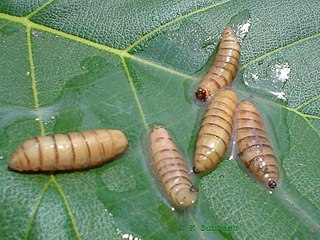 W
WCobboldia is a genus of parasitic flies in the family Oestridae. Adult flies of Cobboldia elephantis lay their eggs near the mouth or base of the tusks of Asian elephant while the related Cobboldia loxodontis parasitizes African elephants. The larvae hatch and develop in the mouth cavity and later move to the stomach. On maturing, the third instar larvae exit from the mouth and drop to the ground to pupate. A fossil species Cobboldia russanovi is known from the frozen remains of Mammoths. Cobboldia roverei Gedoelst, 1915 has been noted from the African Forest Elephant.
 W
WCochliomyia hominivorax, the New World screw-worm fly, or screw-worm for short, is a species of parasitic fly that is well known for the way in which its larvae (maggots) eat the living tissue of warm-blooded animals. It is present in the New World tropics. There are five species of Cochliomyia but only one species of screw-worm fly in the genus; there is also a single Old World species in a different genus. Infestation of a live vertebrate animal by a maggot is technically called myiasis. While the maggots of many fly species eat dead flesh, and may occasionally infest an old and putrid wound, screw-worm maggots are unusual because they attack healthy tissue.
 W
WConopini is a tribe of the flies family Conopidae. The larvae of species are parasitic on bees, especially bumblebees. Most adults will feed on nectar.
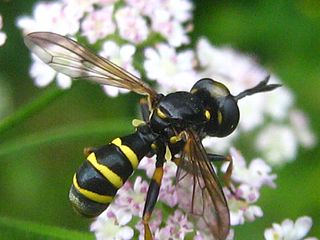 W
WConops is a genus of flies from the family Conopidae. The larvae of Conops are parasitic on bees, especially bumblebees. Adults feed on nectar.
 W
WConops is a subgenus of flies from the genus Conops in the family Conopidae.
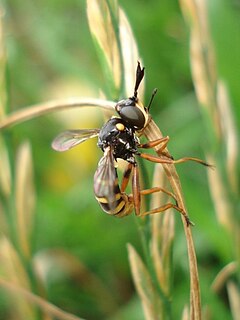 W
WConops ceriaeformis is a species of fly from the genus Conops in the family Conopidae. Their larvae are endoparasites of bees and wasps. The fly is scarce in the United Kingdom.
 W
WConops flavipes is a species of fly from the genus Conops in the family Conopidae. Their larvae are endoparasites of bumble bees of the genus Bombus. It is common throughout much of Europe.
 W
WConops quadrifasciatus, the yellow-banded conops, is a species of fly from the genus Conops in the family Conopidae.
 W
WConops strigatus is a species of fly from the genus Conops in the family Conopidae. Their larvae are endoparasites of bees and wasps. The fly is scarce in the United Kingdom.
 W
WConops vesicularis is a species of fly from the genus Conops in the family Conopidae. Their larvae are endoparasites of bees and wasps.
 W
WCordylobia is a genus of flies from the family Calliphoridae. The larvae of Cordylobia are parasitic on mammals, especially rodents. Two species, C. anthropophaga and C. rodhaini, also are known as parasites of humans. The adult flies feed on rotting fruits, vegetables, and animal faeces, and are most abundant in the wet season. Like many tropical insects, they are most active in the morning and evening. Cordylobia species are largely confined to Africa, though they have been recorded elsewhere when transported by human travellers.
 W
WCordylobia anthropophaga, the mango fly, tumbu fly, tumba fly, putzi fly, or skin maggot fly, is a species of blow-fly common in East and Central Africa. It is a parasite of large mammals during its larval stage. C. anthropophaga has been endemic in the subtropics of Africa for more than 135 years and is a common cause of myiasis in humans in the region.
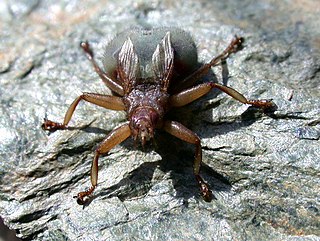 W
WCrataerina is a genus of louse flies in the family Hippoboscidae. All are parasites of birds, feeding on the blood of various species of Apodidae (swifts) and Hirundinidae. The genus is sometimes spelled Craterina.
 W
WCrataerina pallida, the swift lousefly, is a species of biting fly in the family of louse flies Hippoboscidae. These flies are commonly encountered in the nests of the common swift in Europe and Asia.
 W
WCuterebra, or rodent bots, is a genus of flies that attack rodents and similar animals.
 W
WThe Cuterebrinae, the robust bot flies, are a subfamily of Oestridae which includes large, parasitic flies; this group has historically been treated as a family, but all recent classifications place them firmly within the Oestridae. Both genera spend their larval stages in the skin of mammals. The genus Cuterebra, or rodent bots, attack rodents and similar animals. The other genus, Dermatobia, attacks primates, including humans.
 W
WThe name deer botfly refers to any species in the genus Cephenemyia, within the family Oestridae. They are large, gray-brown flies, often very accurate mimics of bumblebees. They attack chiefly the nostrils and pharyngeal cavity of members of the deer family. The larva of Cephenemyia auribarbis, infesting the stag, is called a stagworm. The genus name comes from the Greek kēphēn, drone bee, and myia, fly.
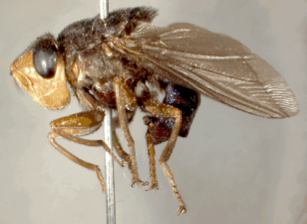 W
WThe human botfly, Dermatobia hominis, is one of several species of flies, the larvae of which parasitise humans. It is also known as the torsalo or American warble fly, though the warble fly is in the genus Hypoderma and not Dermatobia, and is a parasite on cattle and deer instead of humans.
 W
WFannia scalaris, also known as the latrine fly, is a fly species in the Fanniidae family. This species is smaller and more slender than the house fly, Musca domestica, and is similar in appearance to the lesser house fly, Fannia canicularis. The life cycle of this species can be as long as one month. These flies are globally distributed in urban areas as they are drawn to unsanitary environments. F. scalaris is a major cause of myiasis, the infestation of a body cavity by fly maggots. The adults infest bodies that have decomposed, making the species an important part of forensic entomology. The larvae of this fly have adapted protuberances, or feathered appendages, that allow them to survive in such a moist environment. Entomologists continue to research the effects that F. scalaris may have medically, forensically, and on the environment around them.
 W
WThe Gasterophilinae are a subfamily of Oestridae which includes large, parasitic flies; this group has historically been treated as a family, but all recent classifications place them firmly within the Oestridae. Many members of this subfamily spend part of their larval stages in the digestive tracts of herbivores. The best known genus is Gasterophilus, which attacks horses, deer, and similar animals. The genus Cobboldia breeds in elephants. The genus Gyrostigma breeds in rhinoceroses.
 W
WThe Gasterophilus, commonly known as botfly, is a parasitic fly from the family Oestridae that affects different types of animals, especially horses, but it can also act on cows, sheep, goats and, even, it has been recorded a case in a human baby.
 W
WGasterophilus haemorrhoidalis is a species of the genus Gasterophilus that lays eggs on the lips and around the mouth of horses, mules and donkeys.
 W
WHippobosca is a genus of flies in the family Hippoboscidae. There are seven known species. There are numerous synonyms.
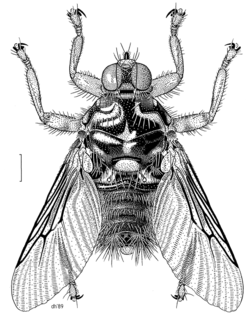 W
WHippobosca equina, also known as the forest fly or New Forest fly, is a biting fly from the family Hippoboscidae. They are blood-feeding ectoparasites of primarily horses and other large mammals including cattle. It is a permanently fully winged fly, not shedding its wings on finding its host, as in some other Hippoboscidae. With its wings retained, it may thus fly away from its host to deposit its larvae. They are good fliers.
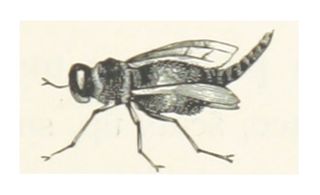 W
WHypoderma tarandi, also known as the reindeer warble fly and reindeer botfly, is a species of warble fly that is parasitic on reindeer.
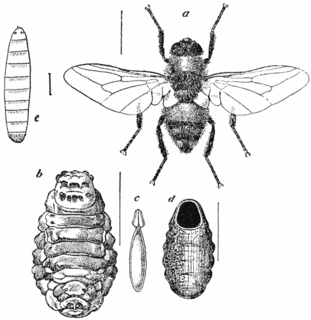 W
WThe Hypodermatinae are a subfamily of Oestridae. The Hypodermatinae include large parasitic flies, some of which are known as warble flies. The 9 genera in this subfamily typically spend their larval stages in the skin or soft tissues of mammals, including bovines. Such species include serious pests of livestock.
 W
WIcosta are genus of biting flies in the family of louse flies, Hippoboscidae. There are 52 known species, making it the largest Hippoboscid genus. All species are parasites of birds.
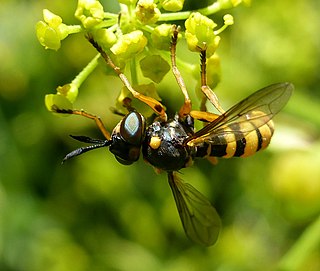 W
WLeopoldius brevirostris is a species of fly from the genus Leopoldius in the family Conopidae.
 W
WLeopoldius signatus is a species of fly from the genus Leopoldius in the family Conopidae.
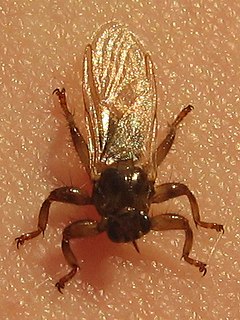 W
WLipoptena is a genus of Hippoboscidae, known as louse flies or keds.
 W
WLipoptena cervi, the deer ked or deer fly, is a species of biting fly in the family of louse flies, Hippoboscidae. These flies are commonly encountered in temperate areas of Europe, Siberia, and northern China. They have been introduced to North America. They are parasites of elk, deer, and other deer family members, burrowing through the fur and sucking the blood of the host animals. Adults are only 5–7 mm (0.20–0.28 in) in length and brownish in colour. Their bodies are flat and elastic, making their removal difficult. L. cervi is a poor flier and can only fly for short distances. Once the insect reaches its target, it sheds its wings and starts burrowing through the fur.
 W
WLipopteninae is a subfamily of the fly family Hippoboscidae. All are parasitic.
 W
WMelophagus is a genus of biting flies in the family of louse flies, Hippoboscidae. There are three known species and one subspecies. All are parasites of bovids. All are wingless.
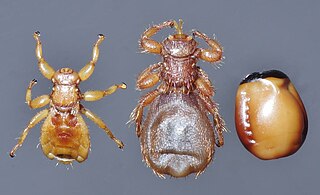 W
WMelophagus ovinus, or the sheep ked, is a brown, hairy fly that resembles a tick. This wingless fly is about 4 to 6 mm long and has a small head; it is a fly from the family Hippoboscidae. They are blood-feeding parasites of sheep. The sheep ked feeds on the blood of its host by inserting its sharp mouthparts into capillaries beneath the skin. The legs of the sheep ked are very strong and tipped with claws. Sheep keds live their whole lives in the wool of sheep. They are most commonly found on the neck, shoulders, and underbelly of the host animal. Although they are often referred to as the “sheep tick”, sheep keds spend their entire lifecycle on their hosts, which is distinguishable from the characteristics of a true tick. Additionally, sheep keds have six legs, whereas true ticks have eight legs.
 W
WMyopa buccata is a species of fly from the genus Myopa in the family Conopidae. Their larvae are endoparasites of bumble bees of the genus Bombus. It is common throughout much of Europe.
 W
WOestrinae is a subfamily of Oestridae which includes parasitic flies attacking a range of different hosts. There are 9 genera with 34 species in this subfamily, which typically spend their larval stage in the skin or soft tissues of mammals, including deer or sheep. The adult flies give birth to living larva in the host's nostril.
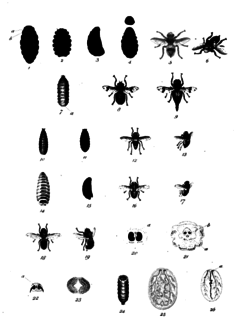 W
WOestrus is a genus of bot flies, from the family Oestridae
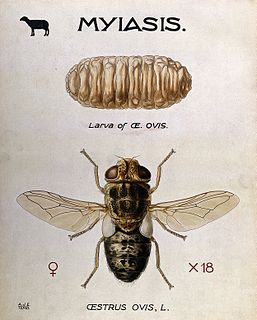 W
WOestrus ovis, the sheep bot fly, is a widespread species of fly of the genus Oestrus. It is known for its parasitic predation and damage to sheep, deer, goats and sometimes cattle. There have also been many records of horse, dog and human infestation. In some areas of the world it is a significant pest which affects the agricultural economy.
 W
WOrnithomyinae is a subfamily of the fly family Hippoboscidae. All are blood feeding parasites, for the most part on birds, though some have mammals as hosts.
 W
WMany species of flies of the two-winged type, Order Diptera, such as mosquitoes, horse-flies, blow-flies and warble-flies, cause direct parasitic disease to domestic animals, and transmit organisms that cause diseases. These infestations and infections cause distress to companion animals, and in livestock industry the financial costs of these diseases are high. These problems occur wherever domestic animals are reared. This article provides an overview of parasitic flies from a veterinary perspective, with emphasis on the disease-causing relationships between these flies and their host animals. The article is organized following the taxonomic hierarchy of these flies in the phylum Arthropoda, order Insecta. Families and genera of dipteran flies are emphasized rather than many individual species. Disease caused by the feeding activity of the flies is described here under parasitic disease. Disease caused by small pathogenic organisms that pass from the flies to domestic animals is described here under transmitted organisms; prominent examples are provided from the many species.
 W
WPhilornis is a genus of around 50 species of fly from Central and South America. Their larvae are subcutaneous parasites of nestling birds. They parasitize a wide range of bird species including macaws at the Tambopata research site.
 W
WPhilornis downsi is a species of fly that was first recorded in Trinidad and Brazil in the 1990s. It has been accidentally introduced to the Galapagos Islands (Ecuador). Adult P. downsi feed on fruit. Eggs are laid in bird nests and hatch into parasitic larvae which reside in the nest material and emerge at night to feed both internally and externally on the blood and flesh of developing nestlings. The parasite is causing significant mortality in Darwin's finch nestlings and threaten the survival of some rarer species such as the mangrove finch and the medium tree finch. In order to protect the threatened finch populations, insecticide-laced cotton has been supplied as nesting material for the finches, with the results being highly successful in combating P. downsi infestations.
 W
WPhysocephala nigra is a species of fly from the genus Physocephala in the family Conopidae. Their larvae are endoparasites of bumble bees of the genus Bombus.
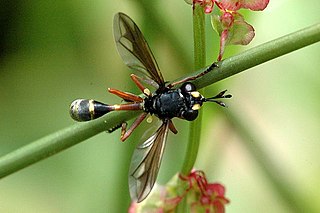 W
WPhysocephala rufipes is a species of fly from the genus Physocephala in the family Conopidae. Their larvae are endoparasites of bumble bees of the genus Bombus. It is common throughout much of Europe.
 W
WPhysocephalini is a tribe of fly from the family Conopidae.
 W
WProtocalliphora or bird blowflies are a blow fly genus containing many species which are obligate parasites of birds. Eggs are laid in bird nests. After hatching, the larvae suck the blood of nestlings. They sometimes feed inside the nostrils of nestling birds and destroy the tissue at the base leading to reduced growth of the upper mandible and the young growing with "shovel-beaks". The species overwinter as adults.
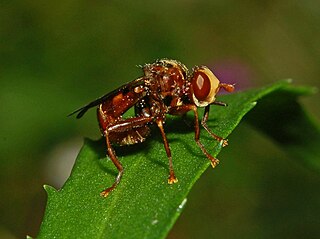 W
WSicus ferrugineus is a species of fly from the genus Sicus in the family Conopidae.
 W
WThe Streblidae are a family of flies in the superfamily Hippoboscoidea, and together with their relatives the Nycteribiidae, are known as bat flies. They are winged or wingless ectoparasites of bats, and often have long legs. They appear to be host-specific, with different species of bat flies occurring only on particular species of bat hosts, sometimes with multiple species of flies sharing a host bat.
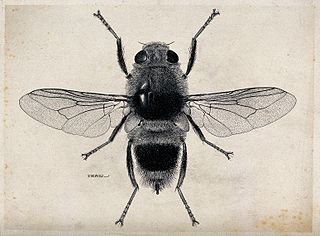 W
WWarble fly is a name given to the genus Hypoderma, large flies which are parasitic on cattle and deer. Other names include "heel flies", "bomb flies" and "gadflies", while their larvae are often called "cattle grubs" or "wolves." Common species of warble fly include Hypoderma bovis and Hypoderma lineatum and Hypoderma tarandi. Larvae of Hypoderma species also have been reported in horses, sheep, goats and humans. They have also been found on smaller mammals such as dogs, cats, squirrels, voles and rabbits.